This post may contain affiliate links. Please read our privacy policy.
Having trouble with getting your baked goods to turn out correctly? Sometimes the solution is simpler than you think! Learn how to measure flour correctly to avoid some basic baking errors.
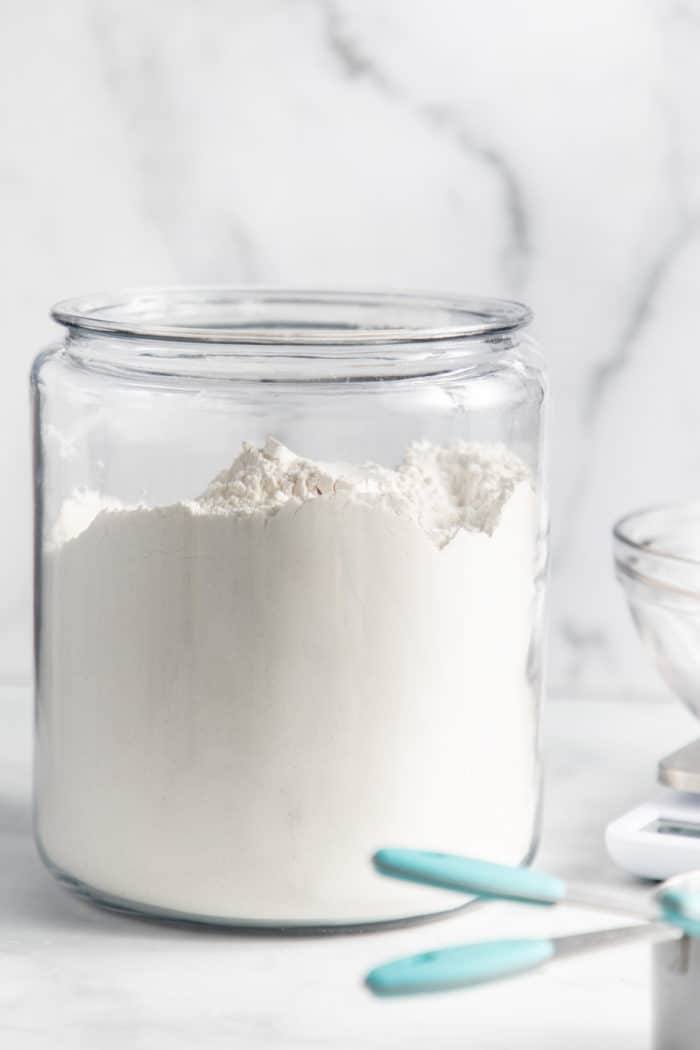
As a food blogger, I try to provide my readers with great recipes that have been tested thoroughly in my kitchen.
However, sometimes a recipe that worked well for me turns out a little less than perfect for a friend or reader.
Whenever my friends ask me why something didn’t turn out right – whether it’s my favorite chocolate chip cookies, the best chocolate cake, or homemade Bisquick, typically the first question I ask is, “How did you measure the flour?”
For years I thought dipping the measuring cup directly into the flour sack was an accurate means of measurement. However, when I started to teach myself how to bake – I realized this method can be pretty inaccurate.
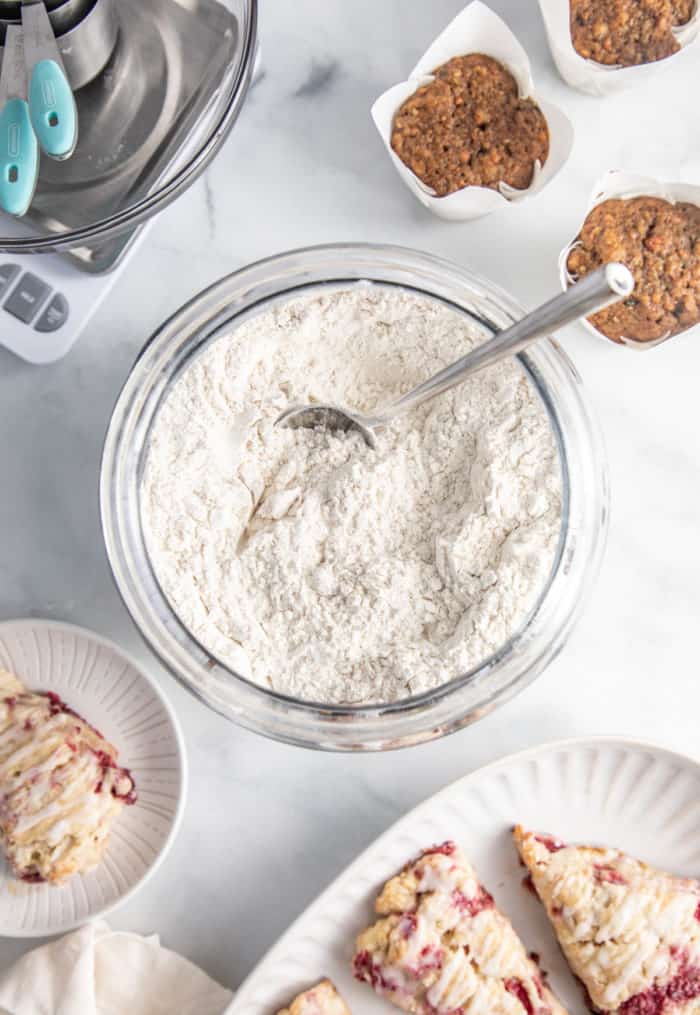
Pin this now to find it later
Pin ItWhy Your Measuring Method Matters
I decided to conduct a little kitchen experiment and measure a cup of all-purpose flour two ways.
Here were the results:
- Scooping a measuring cup into the flour and leveling: 6 oz in weight
- Spooning the flour into a measuring cup and leveling: 4.25 oz in weight
Pretty big difference, right? Especially when it comes to baking. Because just a couple extra ounces of flour can really change the texture of a baked good.
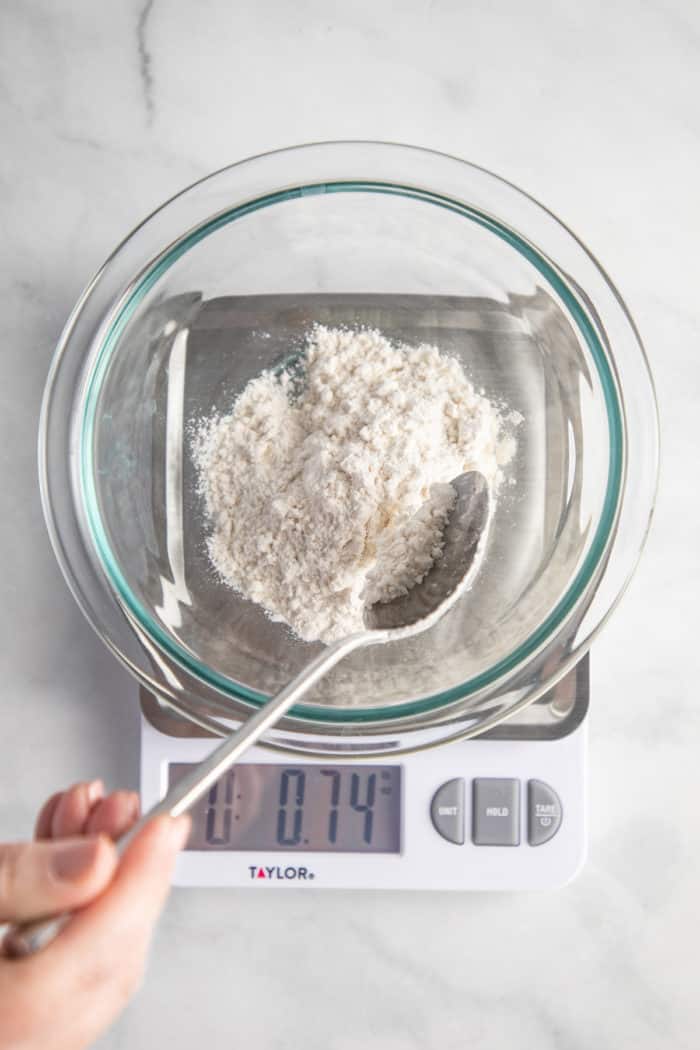
The important thing to remember is that, much like brown sugar, flour packs. Scooping the ingredient with your measuring instrument will cause packing.
Packed flour can add up quickly!
If you have a recipe with 3 cups of flour, and you scoop using your measuring cup, you could end up with 18 ounces of flour, when in reality you should have 12.75 ounces of flour.
That’s nearly an extra 3/4 cup of flour in your recipe!
That can dramatically change the results you get from a finished baked good.
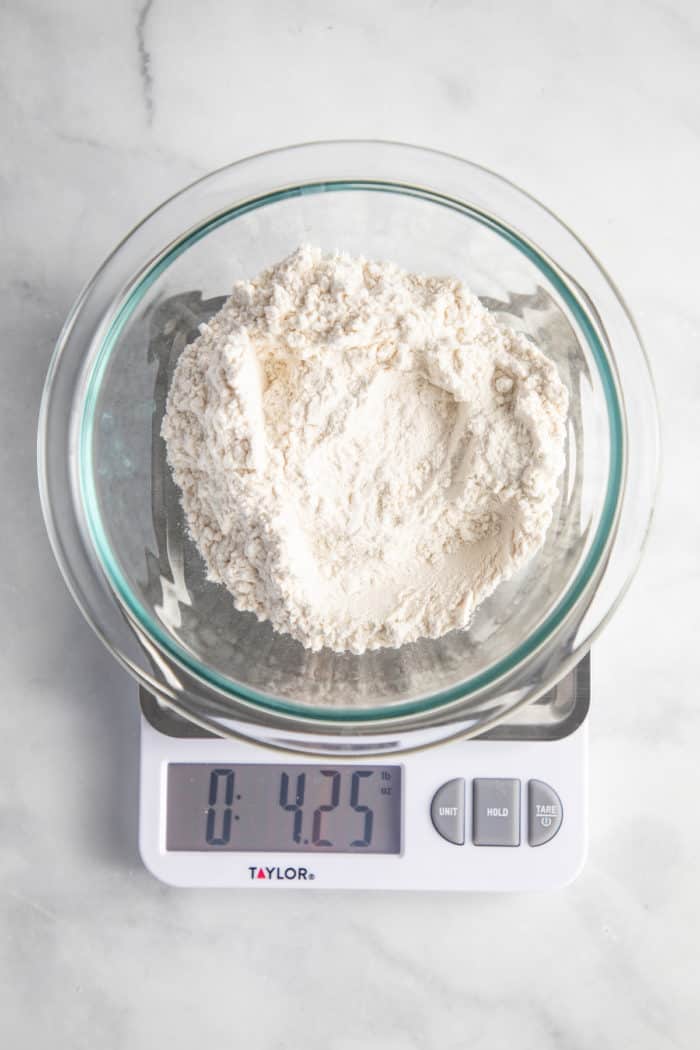
How to Measure Flour for Baking
Flour measurements can be one of the biggest variables when it comes to the finished product in baking. Weighing ingredients is by far the most accurate, but not a common practice here in the U.S.
If you’re an Alton Brown fan – like I am – you know from Good Eats that this is pretty much the only way he measures dry ingredients.
A digital scale can come in handy and is useful for more than just measuring your sugar and flour.
I use mine a lot to weigh small packages for click and ship labels via USPS, and they are also great for figuring out correct portions of meat and other items when needed.
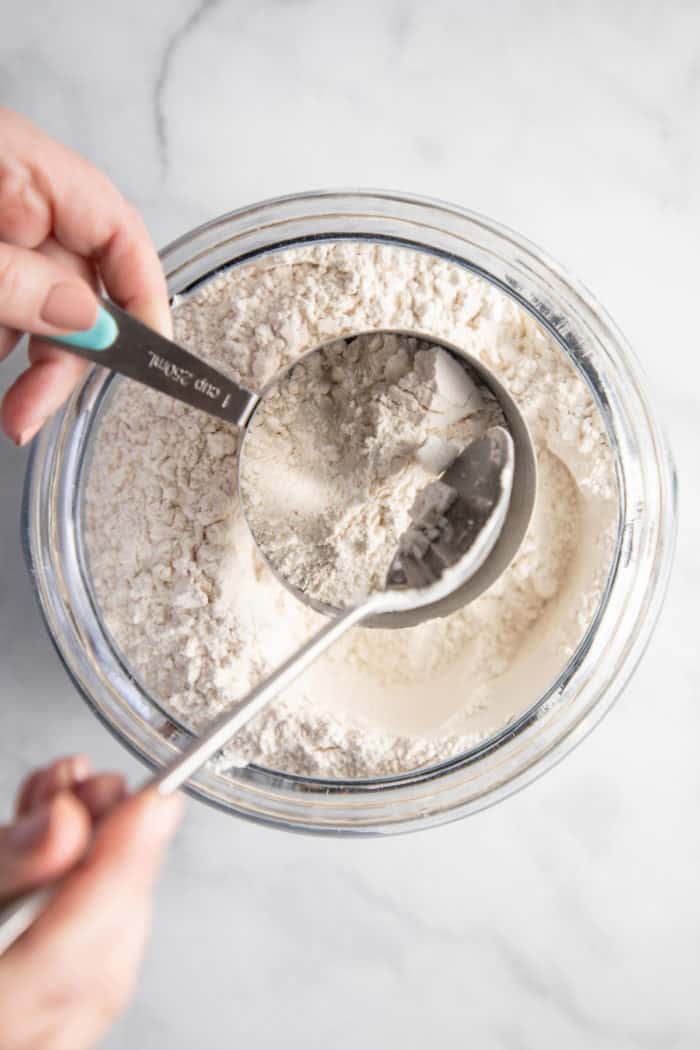
How do I Measure Flour Without a Scale?
If you don’t own a scale, when it comes to dry ingredients, you’re more than likely using a measuring cup.
Many people use measuring cups with perfect results. But remember that they can be incredibly inaccurate depending upon the method of adding the flour to the cup that you use.
What measuring cups should you use?
Although I grew up using both liquid and dry measuring cups, I’ve come to realize through blogging that a lot of people don’t own both types of cups and some don’t know that two types of measuring cups exist.
So, let’s start with the basics – if you’re going to bake, I strongly recommend picking up a set of dry measuring cups as well as at least one liquid measuring cup.
Both can be found in pretty much any store including places like Target, Amazon, the grocery store and even the dollar store.
Make sure you use the dry measuring cups for measuring flour, sugar, and other dry ingredients. Save the liquid measuring cup for milk, water, and other liquid ingredients.
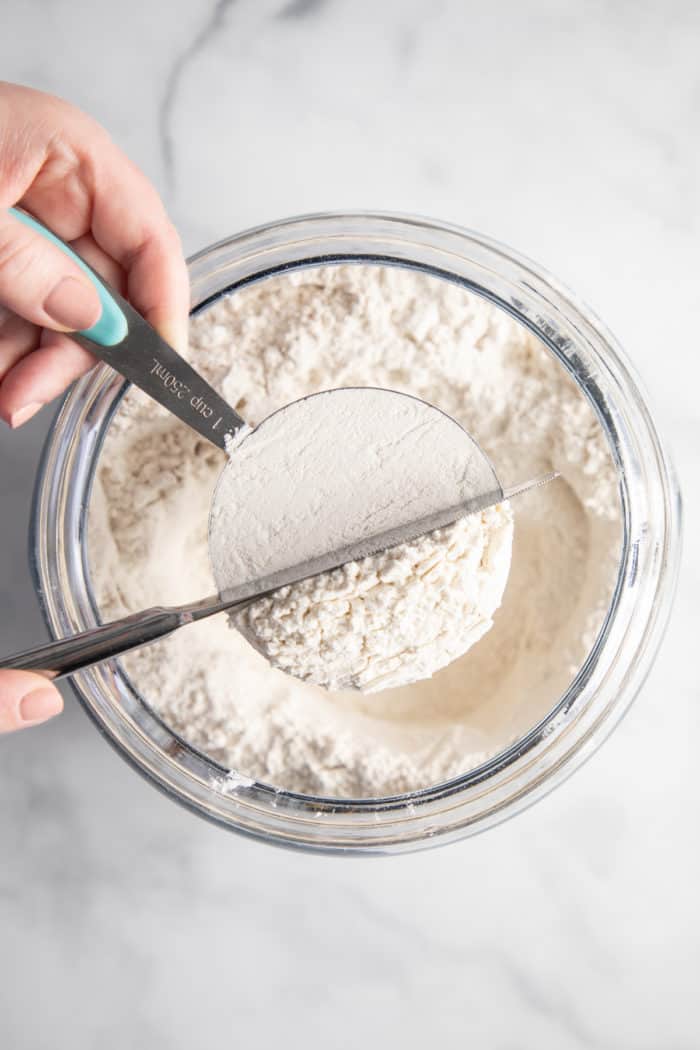
How to get an accurate flour measurement with a measuring cup
Here’s how to get a pretty accurate measurement without the use of a scale:
- Use a spoon to fluff up the flour within the container.
- Use a spoon to scoop the flour into the measuring cup.
- Use a knife or other straight edged utensil to level the flour across the measuring cup. I have a plastic straight edge that I keep in my flour bin at all times for just this purpose.
And that’s it! Now you know how to measure flour the right way so your baked goods are as perfect as possible.
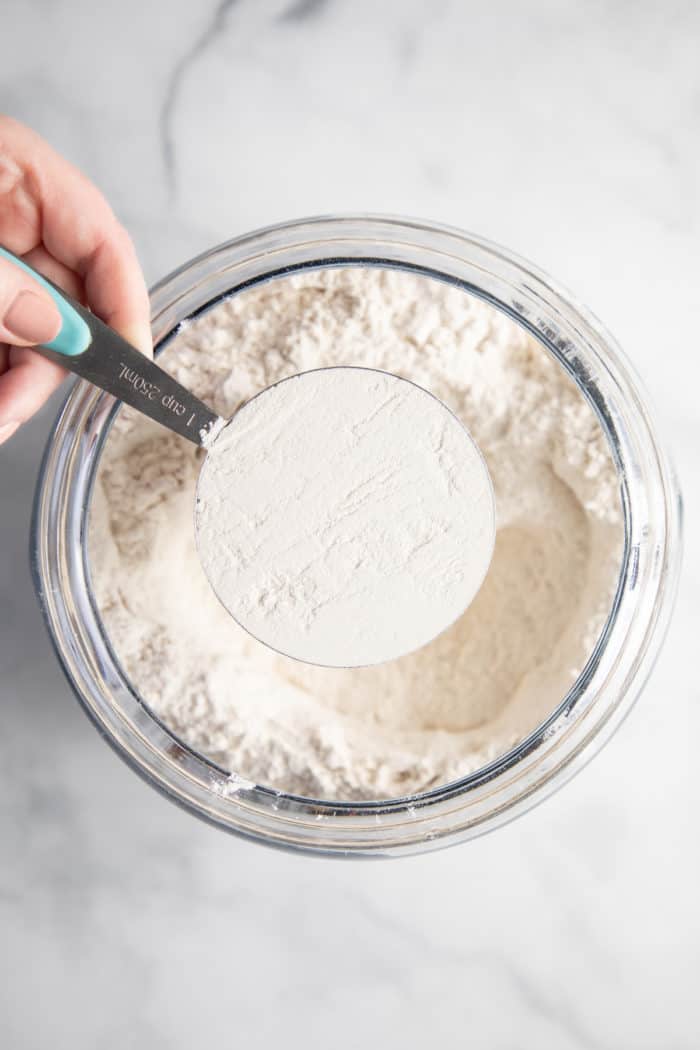
Commonly Used Weight Measurements
Here are some helpful common volumetric measurements and their weight equivalents for quick reference.
All measurements are in ounces by weight, not fluid ounces.
Flours
- all-purpose flour: 1 cup weighs 4.25 ounces
- cake flour: 1 cup weighs 4 ounces
- bread flour: 1 cup weighs 4.25 ounces
Sugars
- granulated white sugar: 1 cup weighs 7 ounces
- confectioners’ sugar (powdered sugar); unsifted: 1 cup weighs 4 ounces
- light or dark brown sugar; packed: 1 cup weighs 7.5 ounces
Butter
- butter: 1 cup weighs 8 ounces
I also definitely recommend printing out a copy of this Ingredient Weight Chart from King Arthur Flour. I laminated mine because I am kind of a messy baker. The list hangs from the side of my fridge, and I can honestly say it is one of my most used kitchen resources.
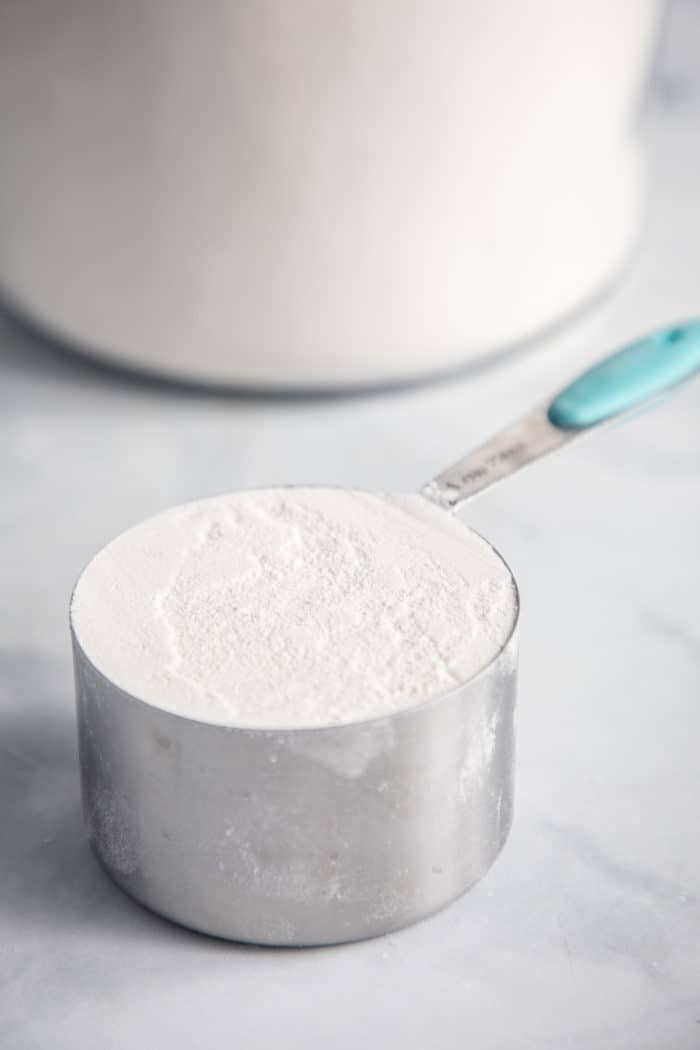
More Helpful Kitchen Tips
Whether you’re a beginner baker or a veteran in the kitchen, there are a few kitchen substitutes and tips that are helpful to keep in mind.
Whip up this simple buttermilk substitute to use in any baking recipe calling for buttermilk.
This brown sugar substitute is also a handy trick to keep in mind in case you find yourself out of brown sugar while in the middle of baking.
It’s also handy to know how to soften butter and how to soften cream cheese quickly! I always forget to set mine out, so I use these tricks all of the time.
How to Measure Flour
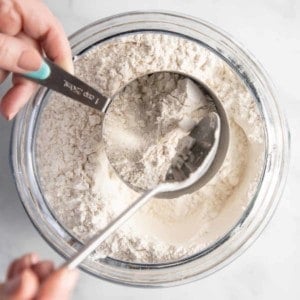
Equipment
- Spoon
- Knife or other straight-edged utensil
Ingredients
- All-purpose flour
Instructions
- Use a spoon to fluff up the flour within the container.
- Use a spoon to scoop the flour into the measuring cup.
- Use a knife or other straight-edged utensil to level the flour across the measuring cup. I have a plastic straight edge that I keep in my flour bin at all times for just this purpose.
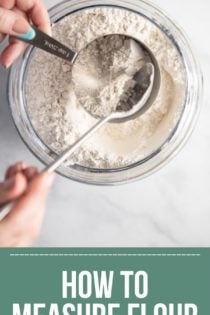
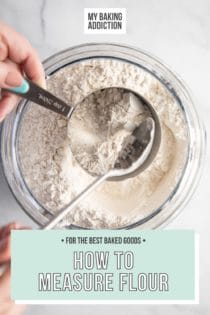
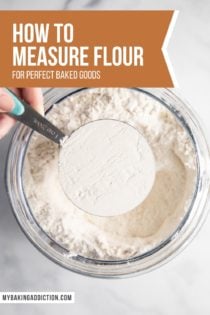
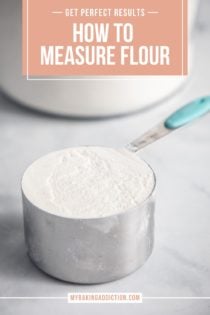
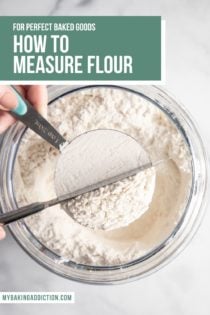









I know I’m a little bit late, seeing as this post was written 10 months ago! :) But – I had a question regarding how to measure flour using a food scale. Will at typical digital scale work? And what would the best method be to measuring it out? Would you just measure it straight on the scale? or tare a cup or something before weighing it? I’m reading this article after months of frustrating baking, getting different results each time I bake, so I do appreciate the information!
Thanks – L. Whitfield
Leslie-
I use a digital scale all the time and simply tare a bowl. Hope this helps!
-Jamie
In the UK we don’t tend to have cups, I’ve been taught and taught myself to bake using weights. This makes using American recipes incredibly difficult, the best I can do is one of my American friends told me that a cup is equal to sixteen tablespoons which was so much faff that I haven’t tried it since. I don’t understand the different terms, either. Such as all purpose flour, cake flour, confectioner’s sugar etc- I have plain flour, self raising flour, granulated sugar (the kind you’d put on your cereal or in your coffee), caster sugar and icing sugar.
I’m confused!! :(
WOW! I was doing this all wrong! I think now that I’m determined to become a “proffesional” baker (because my husband got me a Kitchen Aid stand mixer) I will by a digital scale.
I smiled when I saw this post. Because I have a scale but sometimes too lazy to use it. Now I can measure using your method w/o the scale. Thank you.
Thanks so much for this – I have often wondered how best to measure out dry ingredients in my US recipe books as in the UK our recipes always use weights for flour and sugar etc. Using cups is certainly messier!
Jen
Wish I had read this article before I made my cream cheese pound cake this afternoon. Might have had a better outcome. Thanks for this!
Great post! I learned how to measure flour from that same video this time last year and it changed my baking life! If I baked more often I would probably end up with a scale. Thanks for all the great info.
OMG! I LOVE this article what took me so long to find it. I’m obsessed.
Thanks for sharing your knowledge. Please continue to provide helpful tips like these. Can some one please answer the question that Juliet posted on Oct 24 Post #36 Re: flour – “1 1/3 C flour, sifted” and “1 1/3 C sifted flour”. Is there a difference of when you sift the flour or is this just two variations on the same thing? and the question that Karen posted Oct. 19th Post #16. Re: How do you measure sifted flour? Do you measure the flour before it is sifted or after?
Hi-
To my knowledge – if a recipe calls for “2 cups sifted flour” (the word sifted coming before the word flour) you should sift the flour into a bowl and then measure it. If the recipe says “2 cups flour, sifted” (the word flour coming before the word sifted), you should measure the flour first, then sift it. I always measure the sifted flour in the same way I described in this post. Hopefully this helps! Thanks for stopping by.
-Jamie
Thank You sooooooooo much!!!! this will definately help. I’m glad I stopped by. I’ll try not to wear out my welcome.
I’ve been middle of the road. I scoop with my measuring cup, but first I stick my whisk into the bag of flour to aerate it. Maybe I would come in at 4.75… :)